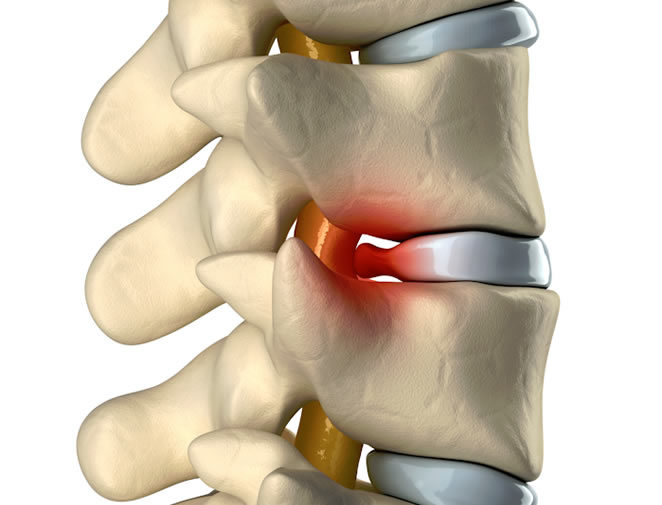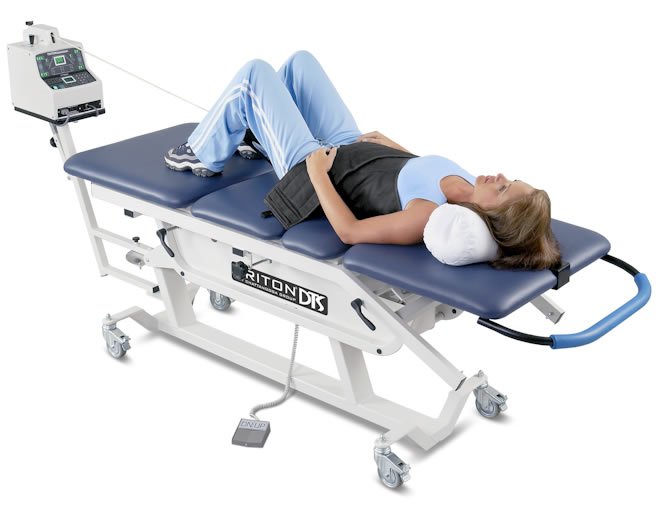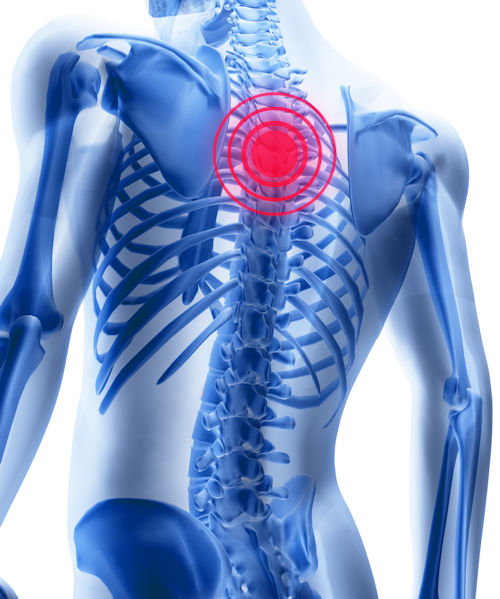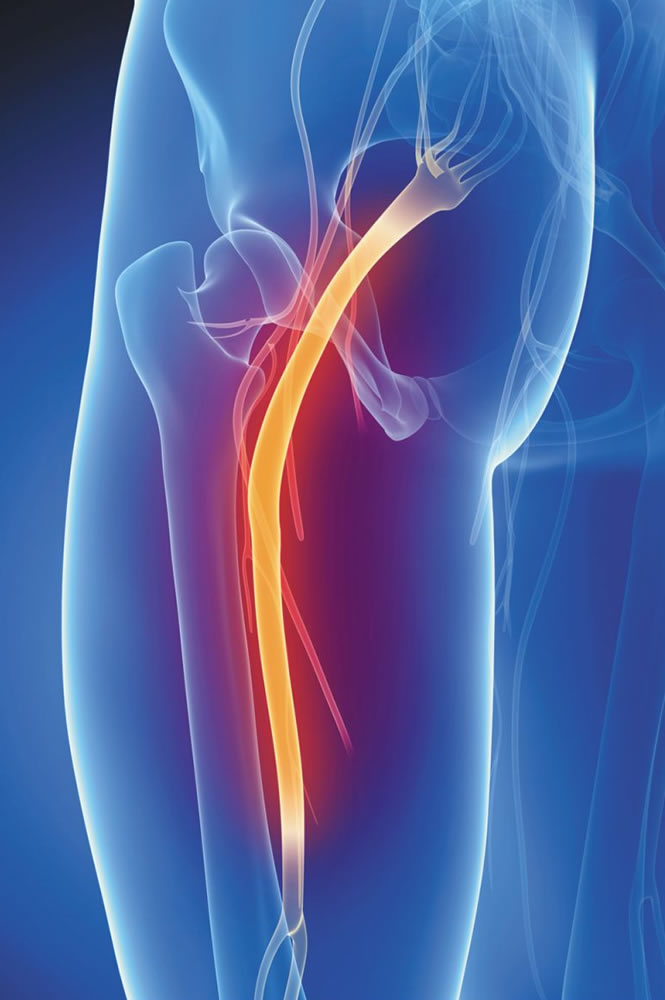

Spinal decompression therapy is a painless and completely non-invasive procedure that has helped thousands of patients become pain-free, and has been shown to be remarkably effective where surgery and other treatments have provided no relief. It is one of the leading long-term treatment options for addressing back and neck problems.
Spinal decompression therapy uses gentle traction to relieve pressure on the vertebrae, the bones that make up the spine. Often, a person’s back or neck pain is due to an abnormal condition of one or more of the discs that act as a cushion or shock absorber between the vertebrae. When these discs bulge, are herniated, or simply wear out, the disc can press or pinch sensitive spinal nerves, which can cause severe pain. Even the wear and tear of daily life and the effects of gravity can cause the spine to compress and deteriorate. This condition, called herniated nucleus pulposus, is often referred to as “slipped disc” or “blown disc.”

Herniated Nucleus Pulposus
In addition to causing significant pain and discomfort, this condition also frequently results in a restriction of the incoming flow of nutrients that the spine needs to heal itself, as well as to fight brittleness and avoid future injuries. The best treatment for this is a spinal decompression table. This treatment gently pulls the vertebrae away from each other, elongating the spine and creating a small vacuum between the vertebrae which pulls the disc back into proper shape or alignment. The procedure is so relaxing that patients often fall asleep during the session.

Spinal Decompression Table
At LiveWell Chiropractic and Wellness Center, Dr. Ridley uses a computerized decompression table to create a healthy negative pressure in the spinal column, allowing the spine to return to its proper position. As the table slowly moves it applies a gentle distraction, or stretching, force to the targeted area of the spine. The computer controls the distraction force which is applied in between periods of relaxation.


Back, leg, arm, and neck pain
Sciatica
Herniated or bulging disc
Degenerative disc disease
Tingling or numbness
Spinal stenosis
Buttock pain
Degenerated disc
Facet syndrome
Foot drop
Groin pain
Hip pain
Leg numbness
Lower back pain
Lumbar disc bulge
Lumbar disc herniation
Pain when coughing
Pain when sneezing
Pinched nerve
Spinal decompression therapy normally takes place over a period of four to six weeks. Many patients enjoy dramatic positive results after even a short time. During the time period of therapy, patients are encouraged to drink plenty of water to help rehydrate the spinal discs and speed the healing process.
Are you limited in daily activities you once enjoyed pain-free? Have you had repeated injections or epidurals without relief? Have you missed work or are you out of work due to pain? Are you considering surgery and are questioning whether it’s the right option?
Talk with Dr. Ridley if you or your loved one has been struggling with these debilitating conditions, and find out if you are a candidate for spinal decompression therapy at LiveWell Chiropractic and Wellness Center.


What is sciatica?
The term sciatica often describes symptoms of leg pain that start in the lower back and move through the buttock down the big sciatic nerve in the back of the leg. Sometimes instead of pain, people experience tingling, numbness or weakness in the legs. People experiencing any of these problems are very uncomfortable and will seek out sciatica treatment. Dr. Ridley is very familiar with this type of pain, and offers a number of chiropractic treatments that alleviate, and often eliminate, the pain and numbness.
People dealing with sciatica pain often describe one or more of the following symptoms:
Constant pain in one leg or one side of the buttock. (Very rarely on both sides.)
Sharp pain that makes it difficult to walk or just to stand up.
Pain that seems to get worse when sitting down.
Numbness, weakness or difficulty moving their leg or foot.
Instead of a dull ache, people often say that the pain feels more like burning, tingling or searing.
Sciatica Treatment
Dr. Ridley takes a holistic approach to every patient, and will review your unique situation before making a recommendation. She has expertise in a number of disciplines, and she may recommend one or more treatments depending on your symptoms and how your body reacts once treatment has begun.


Cervicobrachial syndrome is a general diagnosis used to describe a combination of symptoms such as neck pain with numbness, tingling or pain down the arm or into the shoulder. This syndrome is characterized by pain that radiates into the shoulders and/or arms.
With or without pain, there may also be numbness, weakness and or swelling in the same area. Often there may also be neck pain or headaches.
Schedule a consultation with Dr. Ridley at LiveWell Chiropractic and Wellness Center and find out if you are a candidate for treatment with Spinal Decrompression Therapy.

Q: How does spinal decompression therapy work?
A: Mechanical traction helps to actually reshape and rehydrate damaged, herniated, degenerative, and bulging discs to relieve the pinched nerves and the resulting back, neck, arm and leg pain. This therapy cycles through distraction and relaxation phases, creating negative pressure - a vacuum - within the spine, drawing any herniated spinal matter back into place. The vacuum also draws blood and nutrients into the area. By increasing circulation around the injured disc, non-surgical spinal decompression helps to align the spine, but also reduces inflammation, promoting accelerated healing.
Q: What conditions can benefit from spinal decompression therapy?
A: Decompression has helped people with many conditions associated with disc injury including: neck pain, back pain, herniated discs, protruding discs, bulging discs, sciatica, cervico-brachial syndrome, radiating pain, and pinched nerves. We also have a number of patients who come in to do decompression therapy for wellness, to keep their discs healthy as they age, and to stretch out stiffness.
Q: Are there any contraindications or people who should not do decompression therapy?
A: Anyone who has severe osteoporosis or who has had a surgery of the spine where they have inserted screws, metal plates or cages, should not do decompression on that area of the spine.
Q: Is my back, leg, neck, or arm pain the kind of condition that could benefit from decompression therapy?
A: Neuropathy tends to respond very well to decompression therapy! Symptoms caused by neuropathy are described as severe, sharp and shooting or deep and burning pain; or persistent numbness, tingling or weakness that travels into the arms, hands, legs or feet. Neuropathy can also be characterized by pain resulting from light touch or another stimulus that does not typically cause pain, as well as hypersensitivity to other stimuli.

Serving Hurst, Colleyville, North Richland Hills, Euless, Bedford, Ft. Worth, Grapevine, Southlake, Keller, Dallas, Mansfield, Arlington & Watauga.

Office: (817) 485-WELL (9355)
Fax: (817) 427-9355
Email: livewell@LiveWellDFW.com
© Copyright 2017 LiveWell Chiropractic Health & Wellness Center & Dr. Jennifer Ridley. All Rights Reserved. Website Consulting and Strategy by DRKM Strategies - Web Design by Longman Computers